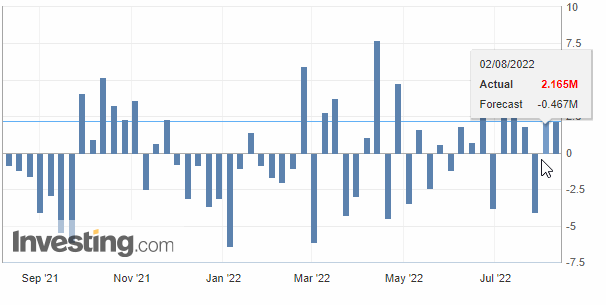The price of crude oil that fell below $90 for the first time in months, struggles to recover the lost ground in the presence of plethora of bad economic news.
As of 10:50 GMT, the prices of WTI and Brent were at $89.98 and $95.61 respectively; the price of LNG, liquified natural gas, was $7.90.
Of course, the fear of recessions is no longer in the hypothetical realm; it is real: both the US and UK are officially in recession and the other major economies are not very far from the event horizon of the economic blackhole.
The Chinese economy, the world's second largest, for instance, suddenly saw its manufacturing PMI - a key indicator that shows its manufacturing activity - falling down back to 49 in July from 50.2 in June; the very index alarmingly fell down to 47.4 in April, before recovering and reaching above 50, before suffering a drop again in July.
In the post-pandemic world, the global economies that suffered a collective blow on all fronts, do not get the necessary boost from high energy costs. In this context, the war in Ukraine, now, appears to be the last straw with Europe being hammered by serious supply woes of oil and gas.
Although the OPEC+ promised to increase the production by a further 100, 000 barrels, analysts branded it too modest to make a dent on the demand curve - they argue it was just a measure to please those who apply pressure on the former.
The US crude inventories, meanwhile, show there had been a build for two consecutive weeks - an unusual trend; in the past few months, the indicator used to oscillate between a build and draw, perhaps on inflated sentiments rather than events of any economic significance, which in turn left it fairly unreliable to gauge the long-term trend in demand.
A crude inventory build of this kind, however, is significant during the summer driving season of the US: there was no boost for the demand in oil during the crucial season that disappointed the markets; motorists have clearly cut down on the use of fuel to save money; according to Rigzone, the demand of gasoline in July is lower than that of every July since 1997.
As the concerns over the demand gather momentum, the possibility of the revival of the JCPOA, 2015 Iran nuclear deal, is grabbing the headlines - once again.
There were even reports of the so-called 'final text' that seems to have bemused Iran for not seeing it in the current form - in the first place. Much to the frustration of the negotiators, however, Iran seems to be holding its ground showing very little flexibility with a major bone of contention being the demand of the latter of a cast-iron guarantee that the US will not walk back on the deal under a new administration.
As far as Iran is concerned it is a case of once-bitten-twice-shy; President Trump cancelled the deal in 2018 on a whim that President Obama was instrumental in brining about in 2015.
In a strange development, meanwhile, the trade between the US and Iran in the first half of 2022 stood at $23.8 million, despite the decade-long animosity between the two nations, according to the United States Census Bureau; it was a 18% rise from the same figure in 2021.
The conflict between Ukraine and Russia, meanwhile, slowly pales into insignificance in the Western media while the war of attrition by Russia continues unabated.
Critics argue what the West really achieved in pushing Russia against the wall, apart from a major energy crisis in Europe that could only get worse in the forthcoming colder months.
The Russian economy certainly was bruised due to heavy sanctions; it, however, did not collapse, as we were led to believe.
On the contrary, its revenue from oil and gas keeps rising, thanks to high commodity prices; when the world's second and third largest consumers of oil and gas, China and India, are on a lucky buying spree, the West has become just a passive spectator with its limited political leverage to rein in the two ambitious buyers, while every major industry of the former receiving hammer blows on energy front.
In a strange twist, even Saudi Arabia, the world's largest exporter of crude oil, has jumped on the bandwagon of buying cheap Russian oil; its imports from Russia have doubled during the Q2 this year in order to meet the demand for its power sector during hot summer months that in turn help the Kingdom not to reduce its export of oil to the rest of the world.
All in all, the tentacles that stem from the recessions of the major economies are going to determine the price of crude oil at present rather than the evolving sentiments of the war between Russia and Ukraine.
It is interesting to see how the major oil producers are going to grapple with the falling oil prices, when they make comeback in boomerang form towards them - in the long run.









